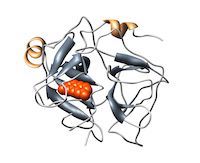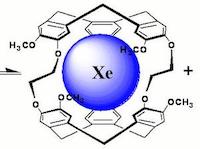In the same section
You will find here an overview of some of our past research projects.
#1 Study of the stability and dynamics of (bio)macromolecular systems

The understanding of the energetics that guide (bio)molecular associations and the nature and types of non-covalent interactions that lead to the selective association of proteins and DNA with other (bio)molecules is of fundamental importance in bio-nano-technology. We have studied for many years the structure, stability, dynamics of (bio)molecuar complexes with the aim of elucidation the non-covalent interactions at the origin of the molecular recognition process (enzyme-inhibitor complexes, interaction between lecitins and sugars, oligonucleotides, organic receptors, ...).
The main experimental techniques that we used are ITC and DSC microcalorimetry, NMR spectroscopy, UV-Vis spectroscopy and circular dichroïsm.
Heads: Profs Kristin Bartik & Gilles Bruylants
Co-workers/researchers: Dr Marina Boccongelli
Collaboration: Dr Christina Redfield (University of Oxford)
Funding: FNRS, Fondation Wiener-Anspach
Publications:
Comparison of the Thermodynamics and Base-Pair Dynamics of a Full LNA:DNA Duplex and of the Isosequential DNA:DNA
Bruylants G., Boccongelli M., Snoussi K. and Bartik K., Biochemistry 48(35), 8473-8482 (2009).
Aromatic – Carbohydrate Interactions: an NMR and Computational Study of Model Systems
Vandenbussche S., Díaz M., Fernández-Alonso C., Pan W., Vincent S., Cuevas G., Javier Cañada F., Jiménez-Barbero J. and Bartik K., Chemistry 14(25), 7570-7578 (2008).
Protonation Linked Equilibria and Apparent Affinity Constants : The Thermodynamic Profile of the α-Chymotrypsin-Proflavin Interaction
Bruylants G., Wintjens R., Looze Y., Redfield C. and Bartik K., Eur. Biophysics J. 37, 11-18 (2007).
Developments in the Characterisation of the Catalytic Triad of α-Chymotrypsin: Effect of the Protonation State of Asp102 on the 1H NMR Signals of His57
Bruylants G., Redfield C. and Bartik K., Chem. Bio. Chem. 8, 51-54 (2007).
Oligonucléotides chimiquement modifiés : outils diagnostiques et agents thérapeutiques prometteurs. Méthodes permettant d’étudier leur stabilité et sélectivité d’appariement
Boccongelli M. and Bartik K., Chimie Nouvelle 93, 101-108 (2006).
Structural Characterization of the Papaya Cysteine Proteinases at low pH
Huet J., Looze Y., Bartik K., Raussens V., Wintjens R. and Boussard P., Biochemical and Biophysical Research Communications 341, 620-626 (2006).
Use of Isothermal Titration Calorimetry for the Study of Intercations between (bio)Molecules
Bruylants G. and Bartik K., Chimie Nouvelle 23(88), 9-14 (2005).
Differential Scanning Calorimetry in Life Science : Thermodynamics, Stability, Molecular Recognition and Application in Drug Design
Bruylants G., Wouters J. and Michaux C., Current Medicinal Chemistry 12(17), 2011-2020 (2005).
Study by 23Na-NMR, 1H-NMR, and ultraviolet Spectroscopy of the Thermal Stability of an 11-basepair Oligonucleotide
Cahen P., Luhmer M., Fontaine C., Morat C., Reisse J. and Bartik K., Biophysical Journal 78, 1059-1069 (2000).
#2 Origin of life and homochirality on Earth
We have been interested in the laboratory for many years in fundamental issues related to the origin of Life on Earth. We have more particularly addressed the issue of the role of water in the transition form non-living to living matter. We have also investigated, both experimentally and theoretically, several scenarii that could eventually explain the origin of the homochirality on Earth. Enantiospecificity is an important aspect of biological processes and Life on Earth today is intimately linked to the homochirality of the constituents of living organisms (proteinic aminoacids, sugars present in nucleic acids...).
Head: Profs Jacques Reisse & Kristin Bartik
Co-workers/researchers: Dr Sophie Vandenbussche
Funding: FNRS
Publications:
The search for a deterministic origin for the presence of non-racemic amino-acids in meteorites: a computational approach
Vandenbussche S., Reisse J., Bartik K. and Liévin J., Chirality 23, 367-373 (2011).
Prebiotic chemistry : a fuzzy field
Bruylants G., Bartik K. and Reisse J., Comptes rendus – Chimie 14, 338-391 (2011).
Liquid water : a necessary condition for all forms of life ?
Bartik K., Bruylants G., Locci E. and Reisse J., in Origins and Evolulution of Life: an astrobiological perspective, Gargaud M., Lopez-Garcia P., Martin H. (Editeurs), 205-217, Cambridge University Press (2011).
Is it useful to have a clear-cut definition of life? On the use of fuzzy logic in prebiotic chemistry
Bruylants G., Bartik K. and Reisse J., Origins of Life and Evolution of Biospheres 40(2), 137-143 (2010).
Catalysis by mettalloenzymes and the origin of life
Bruylants G., Bartik K. and Reisse J., Bulletin de la Classe des Sciences XIX - Académie Royale de Belgique, 211-217 (2008).
Do Serine Octamers Exist in Solution ? Relevance of this Question in the Context of the Origin of Homochirality on Earth
Vandenbussche S., Vandenbussche G., Reisse J. and Bartik K., Eur. J. Org. Chem. 14, 3069-3073 (2006).
On the Origin of Homochirality on Earth
Reisse J., Bartik K. and Cronin J., Bulletin de la Classe des Sciences XIII - Académie Royale de Belgique, 1-6 (2002).
Origin of life: the role of water in transition from non-living to living matter
Locci E., Bartik K. and Reisse J., Chimie Nouvelle 78, 58-62 (2002).
A Brief Survey of Organic Matter in the Universe
Reisse J. and Bartik K., Chimie Nouvelle 18, 3145-3150 (2000).
#3 Xe as a probe of molecular and supramolecular systems in solution
 Monoatomic xenon has been used to probe cavities in systems ranging from organic host molecules, like cryptophanes and cyclodextrins, to proteins. We have also used xenon to monitor configurational and conformational equilibria in solution. The xenon atom is an excellent probe because it is "inert" in the sense that its presence does not affect the structure of the system being probed. Indeed, xenon interacts with other molecules through London dispersion energy interactions which are much less directional than other interactions, like H-bonds or multipole-multipole interactions. Another reason why xenon is an excellent probe is because it is "sensitive" in the sense that certain of its properties are dependent on the characteristics of the system being probed. Indeed, the xenon NMR parameters are highly dependent on the surroundings of the xenon atom. For these reasons xenon is often referred to in the NMR community as a "spin-spy".
Monoatomic xenon has been used to probe cavities in systems ranging from organic host molecules, like cryptophanes and cyclodextrins, to proteins. We have also used xenon to monitor configurational and conformational equilibria in solution. The xenon atom is an excellent probe because it is "inert" in the sense that its presence does not affect the structure of the system being probed. Indeed, xenon interacts with other molecules through London dispersion energy interactions which are much less directional than other interactions, like H-bonds or multipole-multipole interactions. Another reason why xenon is an excellent probe is because it is "sensitive" in the sense that certain of its properties are dependent on the characteristics of the system being probed. Indeed, the xenon NMR parameters are highly dependent on the surroundings of the xenon atom. For these reasons xenon is often referred to in the NMR community as a "spin-spy".Head: Prof. Kristin Bartik
Collaborations: Prof. Michel Luhmer (ULB, NMR-HR Laboratory), Dr Emanuela Locci (University of Cagliari)
Publications:
Probing Polymer Colloids by 129Xe NMR
Locci E., Roose P., Bartik K. and Luhmer M., J. of Colloid and Interface Science 330(2), 344-351 (2009).
The Potential of the Xenon "Spin-Spy" Methodology for the Study of Configurational Equilibria in Solution
Locci E., Reisse J. and Bartik K., Chem. Phys. Chem. 4, 305-308 (2003).
The Potential of 129Xe NMR Relaxation Measurements for the Study of Heme Proteins
Locci E., Casu M., Saba G., Lai A., Reisse J. and Bartik K., Chem. Phys. Chem. 2, 812-814 (2002).
NMR study of reversible complexation of xenon by cucurbituril
El Haouaj M., Luhmer M., Ho Ko Y., Kim K. and Bartik K., J. Chem. Soc., Perkin Trans. 2, 804-807 (2001).
Probing Proteins in Solution by 129Xe NMR Spectroscopy
Locci E., Dehouck Y., Casu M., Saba G., Lai A., Luhmer M., Reisse J. and Bartik K., J. of Magn. Res. 150, 167-174 (2001).
Can Monoatomic Xenon Become Chiral?
Bartik K., El Haouaj M., Luhmer M., Collet A. and Reisse J., Chem. Phys. Chem. 4, 221-224 (2000).
129-Xe and 1-H NMR Study of the Reversible Trapping of Xenon by Cryptophane-A in Organic Solution
K. Bartik, M. Luhmer, J.P. Dutasta, A. Collet, J. Reisse, J. Am. Chem. Soc. 120, 784-791 (1998).
Probing Molecular Cavities in a-Cyclodextrin Solutions by Xenon NMR
K. Bartik, M. Luhmer, S.J. Heyes, R. Ottinger and J. Reisse, Journal of Magnetic Resonance, SeriesB 109, 164-168 (1995).
